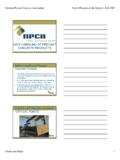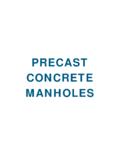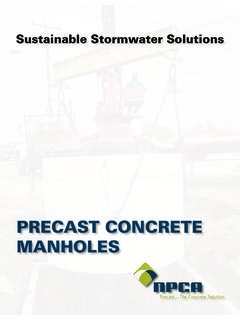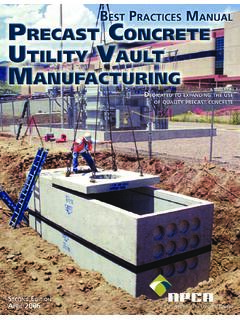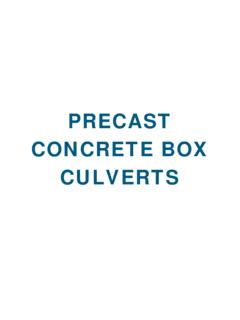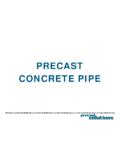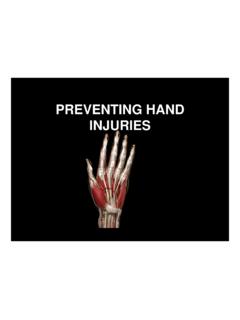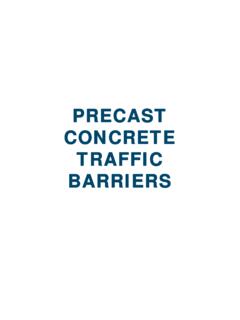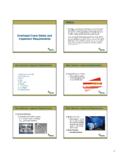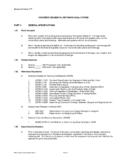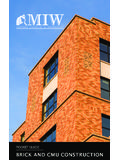Transcription of Precast Concrete Retaining Wall Products
1 NPCA Products Brochure 1 Precast Concrete Retaining Wall ProductsMSE Systems - 5 Modular Block Wall Systems - 6 Unreinforced Modular Block Systems - 7 Reinforced Modular Block - 8 Cantilever Wall - 9 Commercial/Residential Retaining walls - 10 System Information - 11 NPCA Certification - 12 Locate a NPCA Producer - 13 NPCA Products Brochure 2 NPCA Products Brochure 3 Rough and ToughThe strength of Precast Concrete gradually increases over time. Other materials can deteriorate, experience creep and stress relaxation, lose strength, deflect over time and may not be able to withstand vehicular impacts.
2 The load-carrying capacity of Precast Concrete is derived from its own structural qualities and does not rely on the strength or quality of the surrounding backfill materials. Studies have shown that Precast Concrete Products can provide a service life in excess of 100 years. In severe condi-tions, additional design options are available to extend the life of Concrete re Talking Quality HereBecause Precast Concrete Products typically are made in a con-trolled plant environment, they exhibit high quality and uniformity. Problems affecting quality typically found on a job site- tempera-ture, curing conditions, poor craftsmanship and material quality- are nearly eliminated in a plant Is EasySetting Precast Concrete structures into place is easier because they do not require special rigging (such as fabric slings) to avoid structural damage.
3 Other materials such as fiberglass can suffer structural damage during compaction. In contrast, Precast con-crete is less susceptible to vibratory damage while the surround-ing soil is backfilled. Consequently, backfilling operations can usually proceed much faster around Precast Concrete for AnythingWhile no material is completely immune to chemical attack, the mix designs used to produce Precast Concrete can be adjusted to help withstand anticipated corrosive agents. Materials such as steel and other materials quickly deteriorate in the presence of corrosive agents, some in the presence of water alone.
4 To better protect reinforcement from corrosion, the Precast Concrete strength should be designed to 4,000 psi or Concrete walls are generally supported by engineering specific to both the particular wall system and to the project site conditions. This is not always the case with walls built from natu-ral stone materials ( , boulders).DurabilityPrecast Concrete walls are usually made from wet-cast, air-entrained Concrete that is very durable. Resistance to the adverse effects of repeated freeze-thaw cycles and road salts can be significant. Check with the producer to verify the mix design used (including the strength of the Concrete ) and to verify that the producer has a Quality Assurance program in of the Precast Concrete wall systems are made with an ar-chitectural finish that replicates natural stone.
5 In addition, Precast Concrete walls can be stained with a number of commercially available stain Products to further enhance and customize the Good in Green Besides water, Concrete is the most used material on earth. It is nontoxic and environmentally safe. Precast Concrete is addition-ally beneficial because it is made from natural materials. Precast Concrete Products are used throughout the world as part of retain-ing wall systems of nearly every modern Concrete is the choice material for Products used in Retaining wall systems. Precast structures are modular, can fit any design situation, are produced in a quality-controlled environ-ment and are ready to install immediately upon arrival at the job site.
6 Precast Retaining wall components are easily produced to be durable during storage and transportation, easy to install, less vulnerable than competing Products to damage during backfill, and are environmentally safe during Precast Concrete ? Precast Concrete Retaining wall systems have many advantages over competing Products Brochure 4 RecyclingPrecast plants reuse formwork, in itself a conservationist move, and in doing so reduce construction waste that would otherwise be generated at a job site. In addition, cementi-tious materials used in Concrete often contain manufacturing byproducts such as fly ash and blast furnace slag that would otherwise find their way to a landfill.
7 Waste water can be re-cycled for use in manufacturing. Steel used for Concrete rein-forcement is typically composed of 95 percent post-consumer recycled content. Reduced Site ImpactSince Precast Concrete Retaining wall systems are manufactured off site, and delivered on demand, there is a significant reduction in truck traffic, dust, noise, and debris from formwork associated with pour in place Precast Concrete Retaining wall systems are modular and standardized, they are installed in a quicker fashion and result in reduced construction times and energy usage, noise and emis-sions from on-site equipment and in reduced site MaterialsThe cement used in Concrete is made of natural materials such as limestone and clay.
8 Most cement plants rely on nearby limestone quarries. Aggregates used in the manufacturing of Precast Concrete Retaining wall systems are generally extracted and manufactured is a very strong and durable material, which is a signifi-cant sustainable attribute. It will not rust, rot or burn and has a service life of in excess of 100 Concrete and LEEDP recast Concrete Retaining wall systems are a smart choice for projects applying for LEED certification. Most of the credits shown also have additional innovation in Design points that are tied to exemplary performance of the credit for New Construction and Major Renovation 2009 ScorecardSite Development: Protect or Restore Habitat(Sustainable Sites Credit )Due to Precast Concrete Retaining wall systems being plant cast and are delivered to the site ready to set so they require very minimal site disturbance to Waste Management.
9 Divert 50% (75%) From Disposal(Materials and Resources Credit and )Due to Precast Concrete Retaining wall Products being plant cast and are delivered to the site ready to set and create minimal to zero amounts of onsite water Content: 10% (20%) (post-consumer + pre-consumer)(Materials and Resources Credit and ) Precast Concrete Retaining wall systems may contain supplemen-tary cementitious materials such as fly ash and blast furnace slag which will add to the project s recycled content Materials: 10% (20%) Extracted, Processed & Manufac-tured Regionally (Materials and Resources Credit and )The vast majority of materials that go into the construction of pre-cast Concrete Retaining wall Products are within a 500 mi radius of the Precast benefits of Precast DuRing ConstRuCtion MSE SystemsA common Retaining wall used in recent years is the MSE wall system (Mechanically Stabilized Earth).
10 It s classified as a gravity Retaining wall that is designed to withstand lateral earth and water pressures, and any live and dead load stabilized earth walls are built from individual panel sec-tions. Mechanically stabilized earth systems have interlocking panels and are supported by steel straps that are mechanically attached to the back of the panel and extend back from the panel into the retained soil, resulting in a reinforcing zone behind the reinforced soil s mass, along with the facing, acts as an improved gravity wall. The reinforced mass must be built large enough to retain the pressures from the soil behind it.
